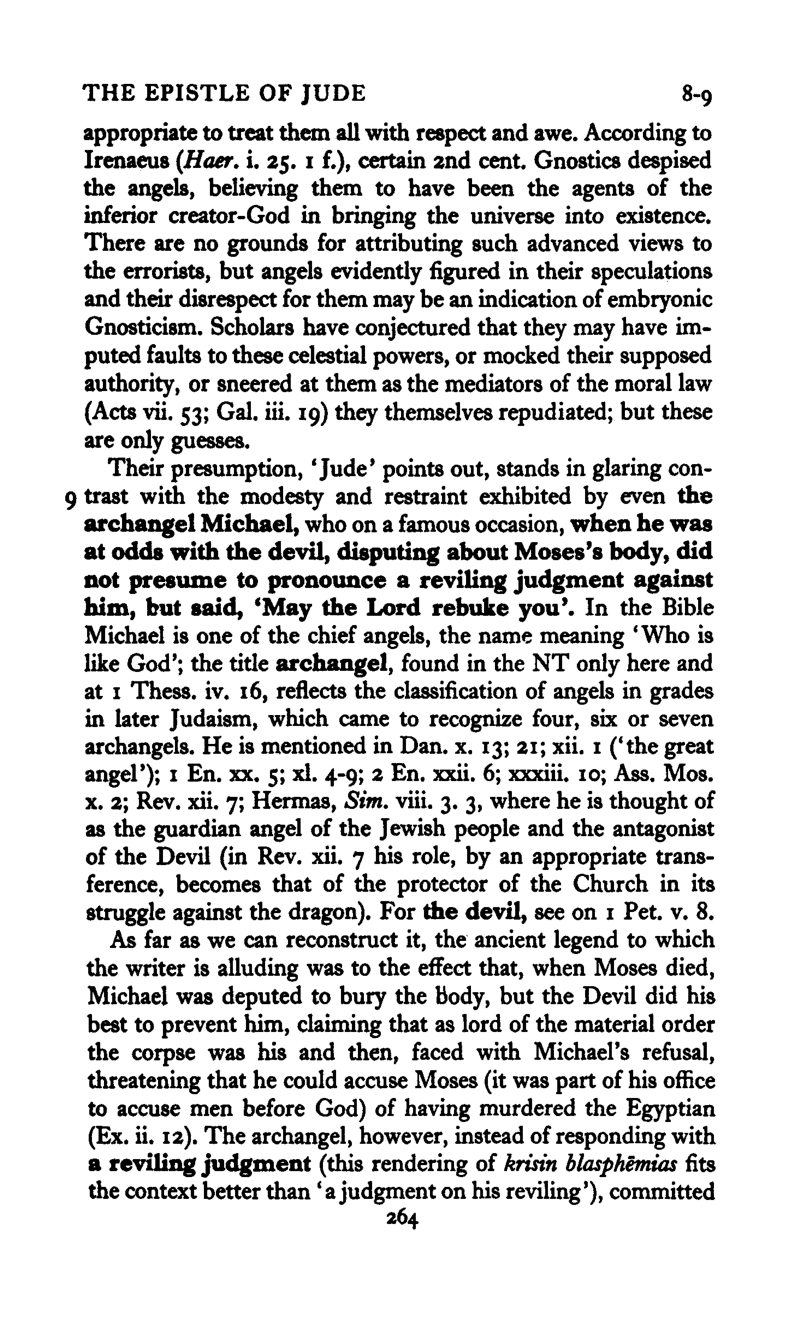J. N. D. Kelly discusses the background to Jude 9.
- Type
- Book
- Source
- J. N. D. Kelly Non-LDS
- Hearsay
- Direct
- Reference
J. N. D. Kelly, A Commentary on the Epistles of Peter and of Jude (Black's New Testament Commentary; London: A. and C. Black Publishers, 1969), 264-65
- Scribe/Publisher
- A and C Black Publishers
- People
- J. N. D. Kelly
- Audience
- Reading Public
- Transcription
Their presumption,' Jude' points out, stands in glaring con9 trast with the modesty and restraint exhibited by even the archangel Michael, who on a famous occasion, when he was at odds with the devil, disputing about Moses's body, did not presume to pronounce a reviling judgment against him, but said, 'May the Lord rebuke you. In the Bible Michael is one of the chief angels, the name meaning 'Who is like God'; the title archangel, found in the NT only here and at i Thess. iv. 16, reflects the classification of angels in grades in later Judaism, which came to recognize four, six or seven archangels. He is mentioned in Dan. x. 13; 21; xii. i ('the great angel'); i En. xx. 5; xl. 4-9; 2 En. xxii. 6; xxxiii. 10; Ass. Mos. x. 2; Rev. xii. 7; Hermas, Sim. viii. 3. 3, where he is thought of as the guardian angel of the Jewish people and the antagonist of the Devil (in Rev. xii. 7 his role, by an appropriate transference, becomes that of the protector of the Church in its struggle against the dragon). For die devil, see on i Pet. v. 8.
As far as we can reconstruct it, the ancient legend to which the writer is alluding was to the effect that, when Moses died, Michael was deputed to bury the body, but the Devil did his best to prevent him, claiming that as lord of the material order the corpse was his and then, faced with Michael's refusal, threatening that he could accuse Moses (it was part of his office to accuse men before God) of having murdered the Egyptian (Ex. ii. 12). The archangel, however, instead of responding with a reviling judgment (this rendering of krisin blasphemias fits the context better than 'a judgment on his reviling'), committed the responsibility for rebuking him for his insolence to God, using a mild imprecation which actually comes from Zech. iii. 2, and proceeded to bury Moses with his own hands. For details, see TWNT IV, 858; 870. The story does not appear in scripture, which merely records (Dt. xxxiv. 6) that 'he [i.e. the Lord] buried him in the valley in the land of Moab opposite Beth-peor; and no man knows the place of his burial to this day*. To eliminate the offensive anthropomorphism the LXX alters the verb to the plural 'they buried'; and Philo (Vit. Mos. ii. 291) relates that 'immortal angelic powers buried him'. According to several early Christian writers (Clement Alex., A dumb, in ep. Iud. Origen, Deprinc.iii. 2. i; Didymus Alex., In ep. lud. enarr. —PG, xxxix, 1815; Gelasius of Cyzicus, Hist. eccl. ii. 20.7), our writer is quoting the legend in the form it appears here from the Assumption of Moses, which he must have regarded as authoritative. This was a composite Jewish apocalyptic work by a Pharisaic quietist, written in Hebrew or Aramaic in the first quarter of the 1st cent, but soon translated into Greek. A substantial fragment survives in a Latin translation, but the sections dealing with the death and burial of Moses are missing from this.
- Citations in Mormonr Qnas
The B. H. Roberts Foundation is not owned by, operated by, or affiliated with the Church of Jesus Christ of Latter-day Saints.

